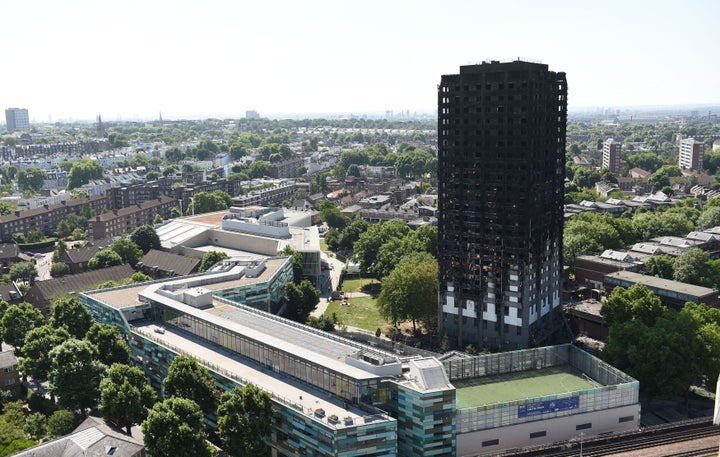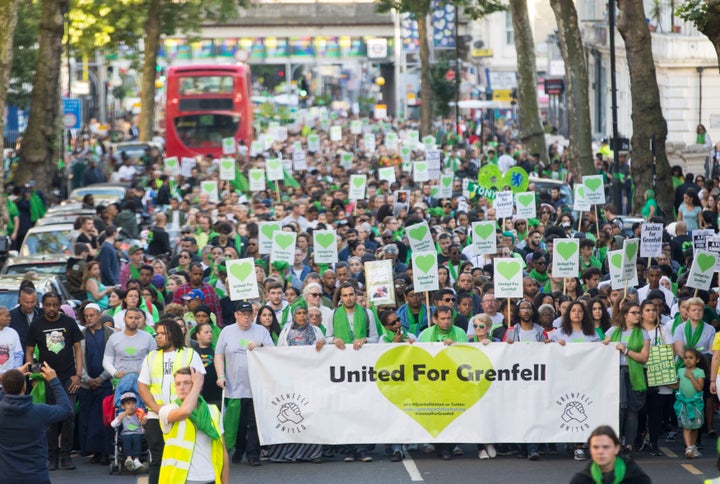
The external wall of Grenfell Tower was “entirely non-combustible” before it was refurbished in 2012 and no provisions were made for disabled people to evacuate the 24-storey building in an emergency, the inquiry into the fire has heard.
Speaking at the hearing on Monday, Dr Barbara Lane listed a number of failed safety regulations, including lifts in the tower that were sub-standard and fire doors that had not been replaced.
Meanwhile the government announced on Monday that they will be launching a consultation on banning the use of combustible materials on the external walls of high-rise residential buildings which are 18 metres or higher.
The government’s move comes after Dame Judith Hackitt’s long-awaited review of building regulations, which was commissioned in the wake of the disaster, which killed 72 people, failed to call for a ban on flammable cladding, sparking outrage when it was released last month.
Expert witness Dr Lane, a chartered fire safety engineer and director at specialist design group Arup, gave a presentation to the inquiry two weeks after her damning report highlighted a host of building safety hazards at Grenfell.
Outlining the code of practice for fire safety guidance in the design, management and use of residential buildings, Dr Lane pointed to section 29.2 which states:
External walls should be constructed using material that does not support fire spread and therefore endanger people in or around the building.
Flame spread over or within an external wall construction should be controlled to avoid creating a route for rapid fire spread bypassing compartment floors or walls.
This is particularly important where a stay put strategy is in place.
Combustible materials should not be used in cladding systems and extensive cavities.
External wall surfaces near other buildings should not be used readily ignitable, to avoid fire spread between buildings.
She told the inquiry that, prior to the tower’s refurbishment, the external wall of Grenfell, including the perimeter beams, consisted of concrete surfaces and glazing.
She continued: “The external wall of the building was, therefore, entirely non-combustible.”
The hearing was told that since the tower was completed in 1974, it had 19 different sets of works carried out on it up until 2017.
Approved Document B of the building regulations lays down measures required to keep tall buildings safe from a blaze, including the ability to contain internal and external fire spread and the provision of access to emergency vehicles, the inquiry was told.
Dr Lane’s report into the fatal blaze said Grenfell did not comply with these building regulations following the 2012-2016 refurbishment.
However, a provision states the document is for “practical guidance” and there “may well be alternative ways of achieving compliance”.
But Dr Lane said during her presentation at Holborn Bars: “I have no evidence that such an alternative approach was considered in matters relating to Grenfell Tower and therefore will not mention the concept of an alternative approach again.”
Addressing the issue of compartmentation, which is designed to keep a fire within the area where it originated, such as an individual flat, Dr Lane said there are no statutory regulations for residential buildings to put measures in place to aide the evacuation of people who ‘require assistance’, such as those who are disabled.

Discussing the means of escape, Dr Lane said: “A person requiring assistance will also need to escape from their flat to the lobby.
“Once they are out in the lobby, they are now separated from the immediate effects of the fire in the flat, however protection measures for the lobby are not intended to provide indefinite protection and it may not be safe for a person to remain within the lobby.”
Dr Lane outlined the following options available to a person requiring assistance to escape:
Escape using the stairs if they are able
Use an evacuation lift, with assistance from building management, if such assistance is available
Use the firefighting lift with assistance from the fire brigade
Be carried down the stairs by firefighters, building management staff or potentially their neighbours.
“There is no provision required in the statutory guidance for residential buildings, unlike other building types, to provide equipment for those persons, so there is no provision made for them to either contact building management, should they even be present in a building, nor to communicate directly with the fire service present in the building,” she said.
“The person can only make a personal 999 call. In other building types refuges with communication devices are required.”
Last month the inquiry heard harrowing accounts from bereaved family members of disabled and elderly residents left unable to escape the blaze.
Nazanin Aghlani told the inquiry that Kensington and Chelsea council’s rehousing team were partly to blame for the death of her mother, Sakineh Afrasehabi, for placing her on the 18th floor of the residential block.
Aghlani said her mother was partially sighted and could only move around with the aid of a walker, yet was rehoused in 2016 into flat 151, despite the council’s own housing department stating in 2003 that she should not live any higher than the fourth floor.
Dr Lane also addressed the “stay put” policy, which has become the focus of much debate since the fire.
Her report published earlier this month said that residents should have been evacuated much earlier, after the strategy failed within about 30 minutes of the first phone call being made to emergency services.
“The statutory guidance makes no provision within the building for anything other than a stay put strategy. There is no means of warning nor a means to communicate the need to increase the areas to be evacuated,” Dr Lane told the inquiry.
“As I explain in my report, I consider the building’s stay put strategy to have failed at 1.26am and that all events after that time occurred in the context of the total loss of the only safety condition provided for.”
But she said the strategy was not one of “fire brigade policy”, adding that it is enshrined in statutory regulations.
Dr Lane added that the “very basis” of the policy relied upon the success of active fire protection measures that proactively tackle blazes, such as smoke extraction systems; passive measures, such as fire doors and fire-resisting walls; and defence in-place measures, such as fire hoses.
Such systems should allow a fire to be contained within the flat of origin, rather than spreading like it did in the disaster last June.
“The statutory guidance makes no provision within the building for anything other than a stay-put strategy,” she told the hearing.
James Brokenshire, the secretary of state for housing, announced on Monday that the consultation, which will run until August 14, will look to revise the building regulations to ban the use of combustible materials in the inner leaf, insulation and cladding that are used in external wall systems on high rise buildings.
“The Grenfell Tower fire was an appalling tragedy and we must do everything we can to ensure a disaster like this never happens again,” Brokenshire said.
“The cladding believed to have been used on Grenfell Tower was unlawful under existing building regulations.
“It should not have been used. But I believe that the changes on which we are consulting will offer even greater certainty to concerned residents and to the construction industry.”
